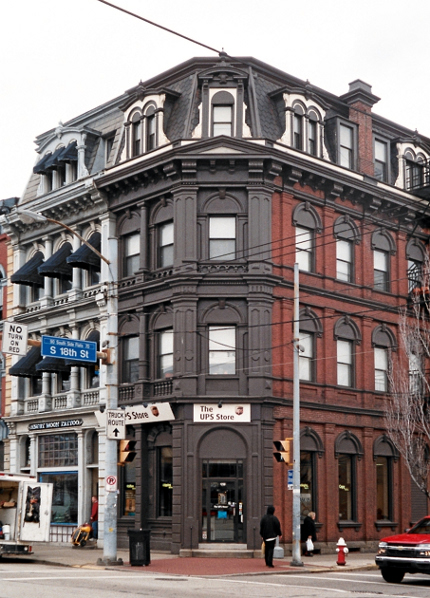
Rainbows glow as the late-afternoon sun hits a fountain in Bessemer Court, Station Square. Behind the fountain is a Bessemer converter salvaged from a steel mill; behind that is the Monongahela with downtown Pittsburgh on the other side.


A South Side alley, crammed with little houses, in the fading light of a summer evening. In dense neighborhoods like the South Side, alleys were built between the main streets to serve the rear entrances of the rowhouses; but soon the real estate became so valuable that, one by one, the property owners sold off their back yards for smaller rowhouses. Alley houses like these are especially typical of the South Side, Lawrenceville, Bloomfield, and the Mexican War Streets, all of them old rowhouse neighborhoods.

Belgian block is a pavement made of brick-shaped stones, more or less uniform, but usually rather less than more. Pittsburghers call it “cobblestone,” having lost the memory of what real cobblestones are like. (A real cobblestone is an irregular smooth, round stone, and cobblestone pavements are quite a bit bumpier than Belgian-block pavements.) Countless Belgian-block pavements still exist in Pittsburgh, and often preparations for repaving an asphalt street reveal the Belgian blocks beneath, still perfectly intact, as they will be when archaeologists dig them up a thousand years from now.
This pavement is on an industrial street near the river on the South Side. Old Pa Pitt admits to not knowing the purpose of what appear to be iron spikes in a more or less straight line.

An inherited camera with fifteen-year-old film took this picture of the front of the South Side Works theater at night. It’s a bit grainy, but recognizable.

Some say that Carson Street on the South Side is the best-preserved Victorian commercial street in the United States. Pittsburghers know it more for its bars and nightclubs, but the whole street is a feast of every kind of Victorian style. Here, a corner location gave some proud shopkeeper a chance to indulge in a bit of Second Empire flourish.

The Pittsburgh and Lake Erie Railroad (which never made it to Lake Erie, by the way) was a little fellow compared to the gargantuan Pennsylvania Railroad. But it made good money, and when it built this station in 1899, it showed that it could play with the big boys. The station cost three quarters of a million dollars, which was a tremendous amount in those days. (It still sounds like a good deal of money to old Pa Pitt.) The interior is madly luxurious, and nowhere more so than in the stained glass. Besides the glorious semicircular window at the western end, the entire ceiling of the grand concourse is stained glass.
Passenger trains no longer stop here (they stop downtown behind the old Pennsylvania Station), but the building has been gloriously restored and turned into the “Grand Concourse,” which must surely be the most architecturally impressive restaurant in the city.

Until the 1890s, rowhouses were the characteristic housing of Pittsburgh, as they were in most large Northeastern cities. These elegant rowhouses on the South Side are among the last of the rowhouse era in Pittsburgh. Soon the well-to-do merchant classes who built these houses would begin to demand detached houses, even if they were detached by only two or three feet.

Flaming red Boston ivy covers the side wall of a house on the South Side.

A masterpiece of industrial architecture, the Kramer Building is a block long and beautifully proportioned. Each of the arches on the first floor is divided into two sub-arches, creating a pleasing and interesting rhythm that makes the building feel much less like a huge slab of brick. The neighborhood across the street is residential, and the building manages not to overwhelm the rowhouses facing it.
So they say in Pittsburgh. This clock on the old Duquesne Brewery may or may not be the world’s largest, but it’s huge (compare it to the houses in the foreground). From across the Mon on the Boulevard of the Allies, it’s the most obvious thing on the South Side. [Update: It should be noted that, since this article was written, at least two larger clocks have been built: the largest in Mecca, and a very large one somewhere in Turkey. This is still the largest clock in the Americas, the Western Hemisphere, the English-speaking world, and a number of other categories one could think of.]
